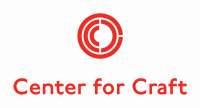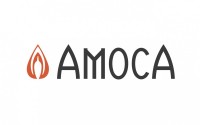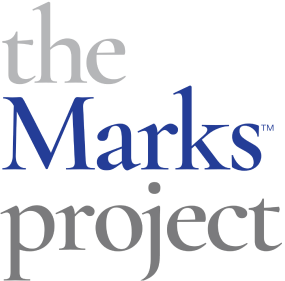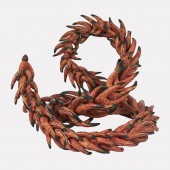![]() Printer version
Printer version
Michael Sherrill
1954 Born Providence, Rhode Island
EDUCATION
— Self-taught
APPRENTICESHIPS AND RESIDENCIES
2004 Residency International Ceramic Museum, Inchon, South Korea
2005 Residency Watershed Center for the Ceramic Arts, New Castle, Maine
2006 Residency Arts and Industry, Kohler Company and John Michael Kohler Arts Center, Sheboygan, Wisconsin
2010 Residency Corning Museum of Glass, Corning, New York
2015 Residency LH Project, Joseph, Oregon
PRIMARY WORK EXPERIENCE
—Studio sculptor working with clay, metal and glass, North Carolina
BIOGRAPHY
Michael Sherrill began his career throwing functional work in traditional forms using traditional glazes. He went on to make a large body of non-functional work based on the bottle form which led to exploring botanical suclptures completed in mixed media.
These pieces began Sherrill’s exploration into the possibilities of surface manipulation and glazes which led to the multi-layered glaze technique used in conjunction with post-firing sandblasting.
Sherrill considers himself a materials-based artist experimenting primarily in the media of clay but also metal and glass. Sherrill states, “I started using my extruder to extrude tubes and then pull tapered, long spouts for my sculptural teapots. My involvement in using an extruder has totally changed my thinking about it as a tool. It widened my view of what I can do with clay. Instead of the extruder being a static tool, just to make an object, I now see it as a workstation like a potter's wheel. It is a place to make and manipulate forms. This is the thing I would like to communicate and share with others. These techniques can open up new possibilities for anyone working in clay.”
Sherrill created a large series of abstracted teapots composed of extruded forms. These pieces were transitional and led to his next series of plant forms referencing both nature and imagination. To produce this new body of work Sherrill expanded his expertise to include metal and glass. He first mastered the art of metal forging which allowed Sherrill to use bronze elements as the structures to hold and display the white stoneware flowers and leaves. These multicolored ceramic botanicals required as many as 4 firings and a process of layering and removing color. Next, he looked to glass lampwork to create the glittery small parts of the flowers. The inspiration for these sculptures comes from his rural environment in the mountains of North Carolina.
Sherrill is the creator of Mudtools, a company born out of a need to create innovative clay tools for himself.
PUBLIC COLLECTIONS
American Museum of Ceramic Art, Pomona, California
AmSouth, Birmingham, Alabama
Columbia Museum of Art, South Carolina
Columbus Museum, Columbus, Georgia
Corning Museum of Glass, Corning, New York
Fuller Craft Museum, Brockton, Massachusetts
Hickory Museum of Art, Hickory, North Carolina
John Michael Kohler Arts Center, Sheboygan, Wisconsin
Los Angeles County Museum of Art, Los Angeles, California
Mint Museum, Charlotte, North Carolina
Museum of Arts and Design, New York, New York
Museum at Icheon World Ceramics Center, Icheon-si, Gyeonggi-do, Korea
Racine Art Museum, Racine, Wisconsin
Smithsonian American Art Museum, Renwick Gallery, Washington, DC
Southern Highland Craft Guild, Asheville, North Carolina
Takoma Glass Museum, Tacoma, Washington
The Howard Hughes Foundation, Bethesda, Maryland
White House Collection, Clinton Presidential Library, Little Rock, Arkansas
BIBLIOGRAPHY
Aimone, Steven. Design! A Lively Guide to Design Basics for Artists and Craftspeople. Asheville, NC: Lark Books, 2004.
Baird, Daryl E. The Extruder Book. Waterville, OH: American Ceramic Society, 2000.
Byrd, Joan Falconer. “Natural Narratives.” American Craft (April/May 2010).
Clark, Garth. The Artful Teapot. New York, NY: Watson-Guptill, 2001.
Del Vecchio, Mark. Postmodern Ceramics. New York, NY: Thames & Hudson, 2001.
Ferrin, Leslie. Teapots Transformed: Exploration of an Object. Madison, WI: Guild Publishing, 2000.
Flint Institute of Arts. Function, Form & Fantasy: Ceramics from the Dr. Robert & Deanna Harris Burger Collection. Flint, MI: Flint Institute of Arts, 2016
Koplos, Janet and Bruce Metcalf. Makers: A History of American Studio Craft. Chapel Hill, NC: The University of North Carolina Press, 2010.
Lark Books (ed.). The Nature of Craft and the Penland Experience: Celebrating the 75th Anniversary of Penland School of Crafts. Asheville, NC: Lark Books, 2004.
Lark Books. The Nature of Craft and the Penland Experience: Celebrating the 75th Anniversary of Penland School of Crafts. Asheville, NC: Lark Books, 2004.
________. The Penland Book of Ceramics: Master Classes in Ceramics Techniques. Asheville, NC: Lark books, 2003.
Lauria, Jo. Color and Fire: Defining Moments in Studio Ceramics, 1950 – 2000. New York, NY: Rizzoli International Publications, 2000.
Mecham, Michelle Francis, ed. The Living Tradition, North Carolina Potters Speak. Conover, NC: Goosepen Studio & Press, 2009.
Morgenthal, Deborah, Suzanne J. E. Tourtillott and Evan Bracken. The Penland Book of Ceramics: Master Classes in Ceramics Techniques. Asheville, NC: Lark Books, 2008.
Monroe, Michael. The White House Collection of American Crafts. New York, NY: Harry N. Abrams Publishers, 1995.
Ostermann, Matthias. The Ceramic Surface. Philadelphia, PA: University of Pennsylvania Press, 2002.
Pancioli, Diana. Extruded Ceramics. Asheville, NC: Lark Books, 2002.
Piche, Tom. Everson Ceramic National. Syracuse, NY: Everson Museum of Art, 2000.
Scotchie, Virginia. Setting Up Your Ceramics Studio: Ideas and Plans for Working Artists. Asheville, NC Lark Books, 2003.
“The Nature of Craft and the Penland Experience.” Ceramics Monthly 52, no. 7 (September 2004).
Triplett, Kathy and Suzanne Tourtillott. Five Hundred Teapots: Explorations of a Timeless Design. Asheville, NC: Lark Books, 2002.
WEBSITE(S):
 | Southern Highland Craft Guild |
 | Center For Craft |
 | AMOCA American Museum of Ceramic Art |
Citation: "The Marks Project." Last modified July 19, 2023. http://www.themarksproject.org:443/marks/sherrill-1











